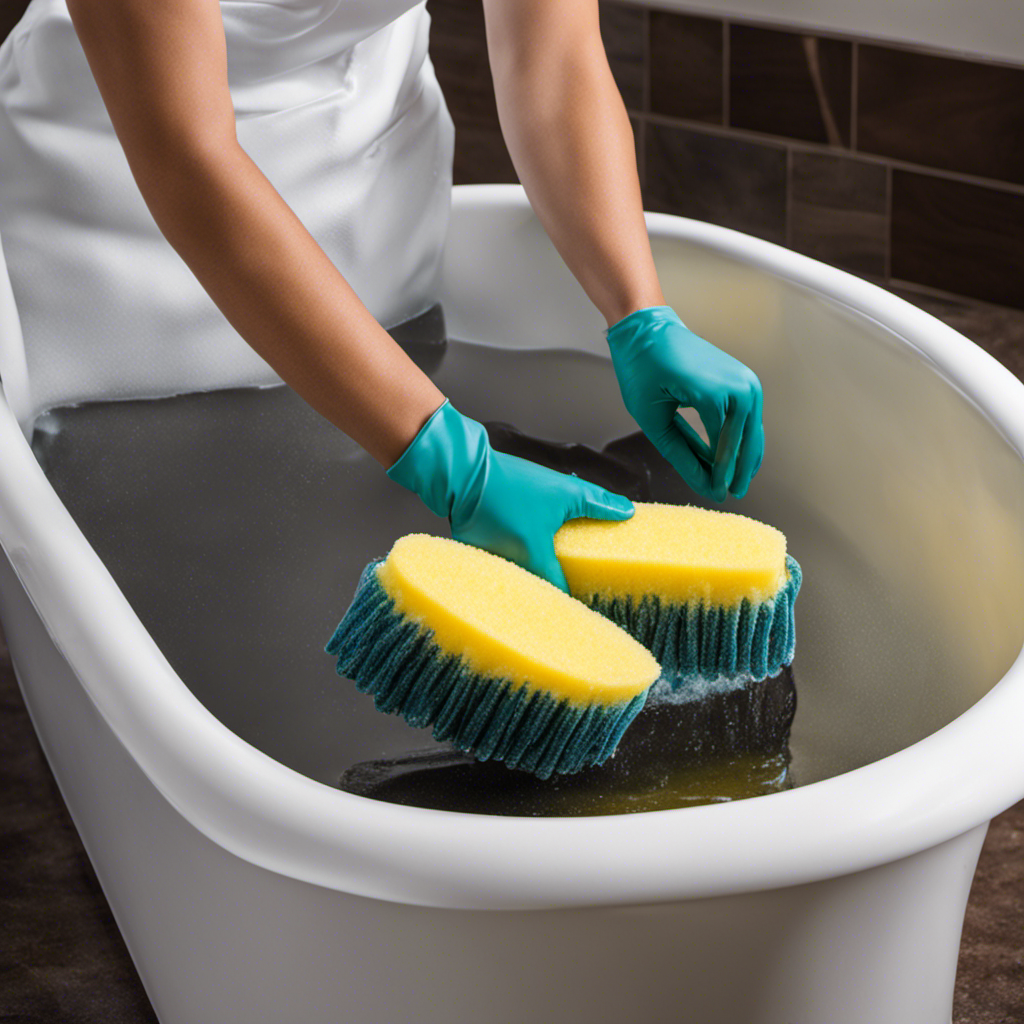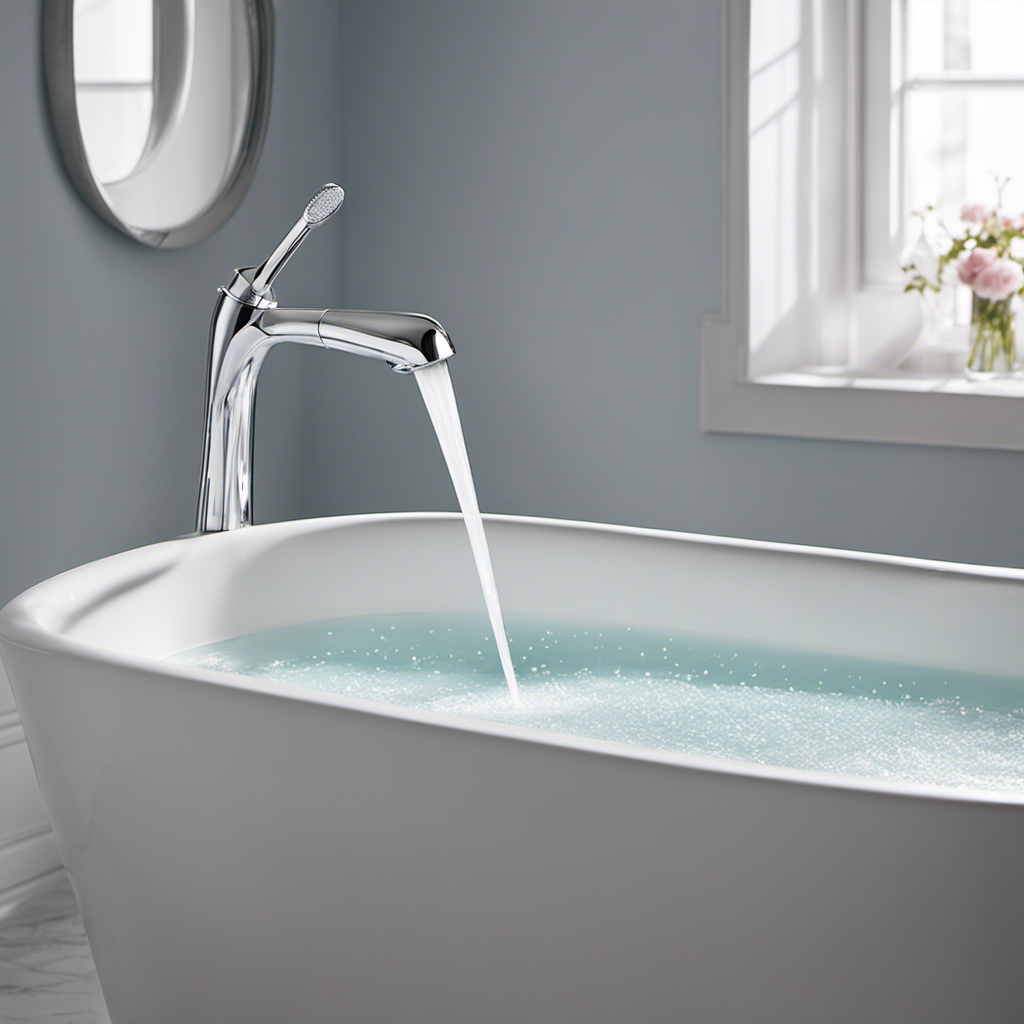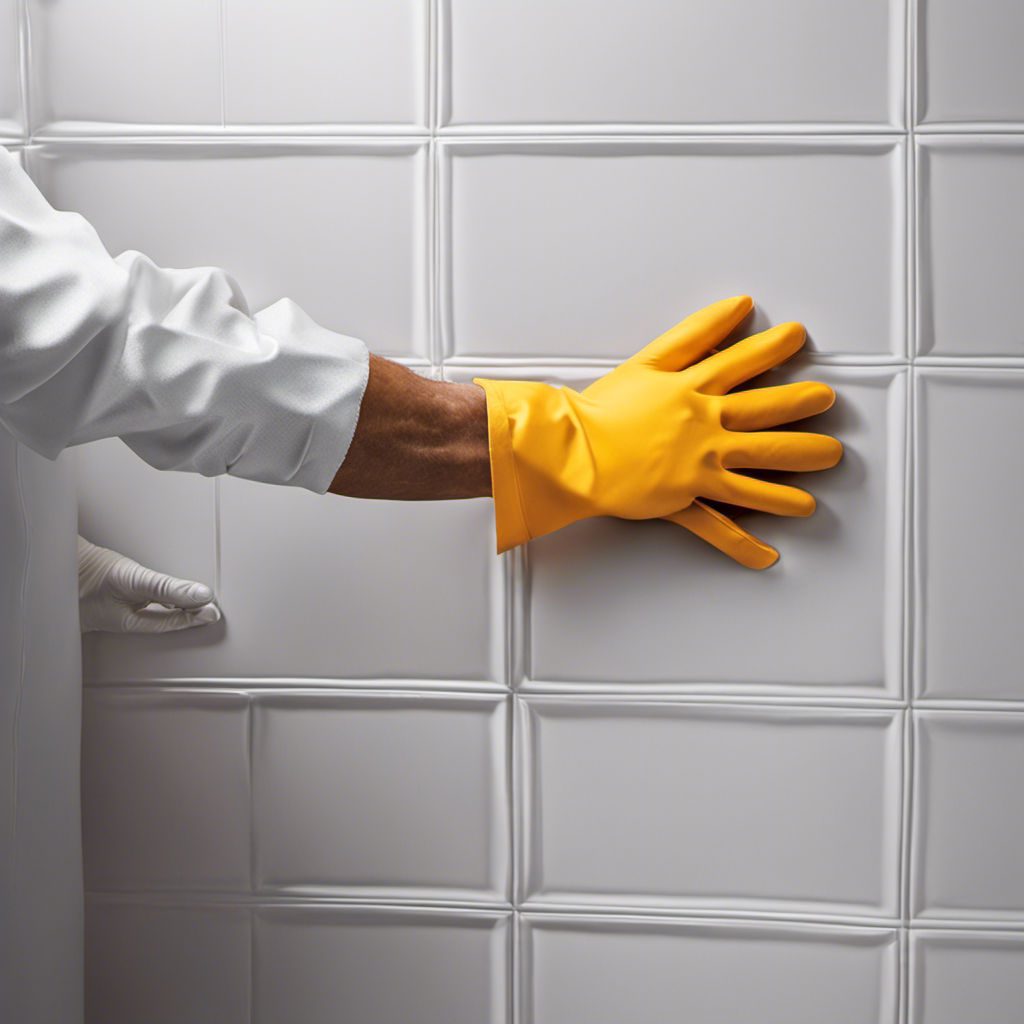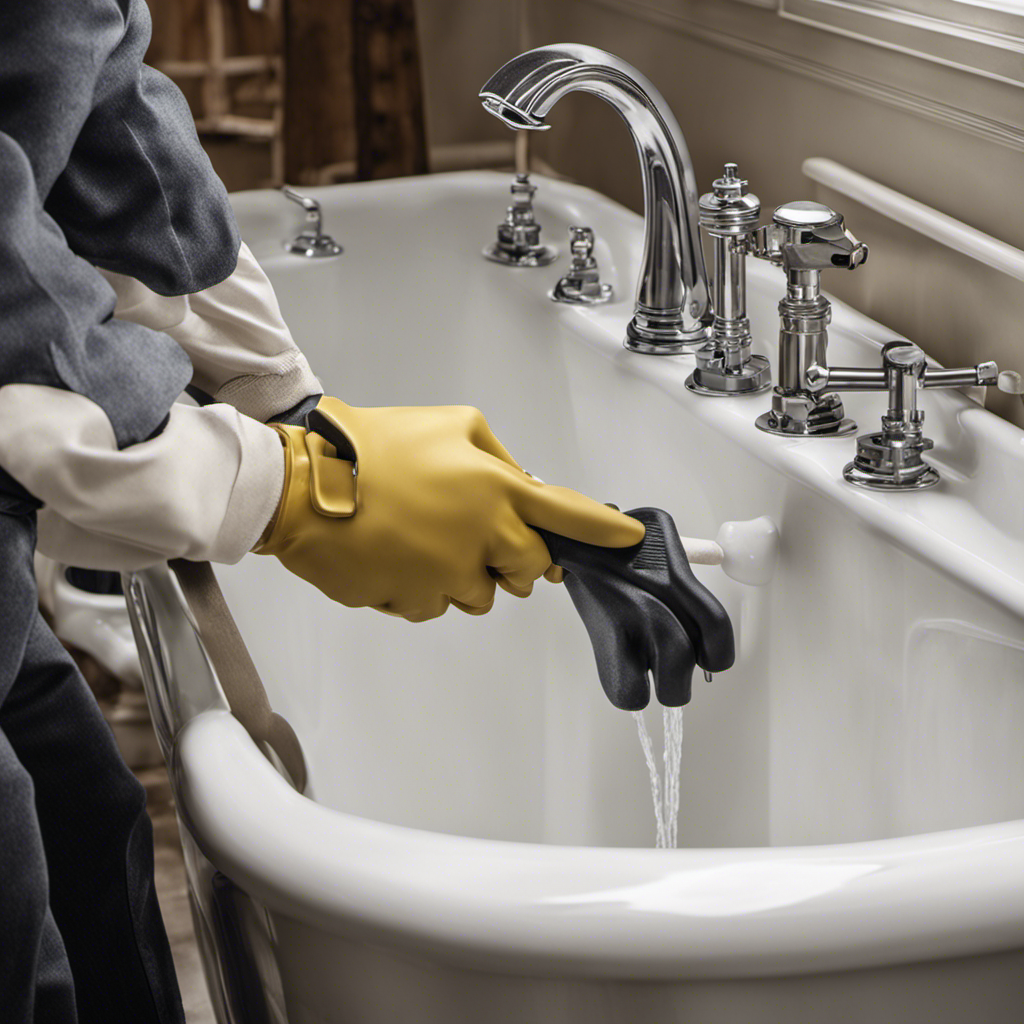Are you tired of stepping into a grimy, dirty bathtub? Well, fear not! We’ve got the solution to your problem.
In this article, we’ll show you how to clean your plastic bathtub like a pro. With just a few simple steps, you’ll be able to restore your bathtub’s shine and leave it looking brand new.
So, grab your cleaning supplies and let’s get started!
Key Takeaways
- Select a mild, non-abrasive cleaner designed for plastic surfaces and avoid using harsh chemicals or abrasive scrubbers.
- Use warm water to loosen dirt and grime without causing damage, and be cautious not to use hot water as it may warp or deform the plastic.
- Create a paste of baking soda and water for stubborn stains, and gently buff the surface in circular motions to remove tough stains from plastic bathtubs.
- Regularly clean the tub at least once a week to prevent soap scum buildup, and wipe down the tub after each use with a squeegee or towel to remove water and soap residue.
Step 1: Gather Cleaning Supplies
First, you’ll need to gather all the cleaning supplies necessary for the job.
When it comes to cleaning a plastic bathtub, using the right cleaning products and maintaining the appropriate water temperature are crucial.
Start by selecting a mild, non-abrasive cleaner specifically designed for plastic surfaces. Avoid using harsh chemicals or abrasive scrubbers that could damage the bathtub’s surface. Additionally, check the manufacturer’s instructions for any specific cleaning recommendations.
Now, let’s talk about water temperature. Using warm water is generally recommended for cleaning plastic bathtubs, as it helps to loosen dirt and grime without causing any damage. However, be cautious not to use hot water, as it may warp or deform the plastic.
Step 2: Remove Surface Debris
Next, use a soft sponge or cloth to wipe away any loose dirt or residue from the surface. This step is crucial in preparing your plastic bathtub for a deep clean.
When choosing the water temperature, it’s important to consider your bathtub’s material. Most plastic bathtubs can handle hot water, but it’s best to consult the manufacturer’s guidelines to avoid any damage. Warm water is generally a safe option.
As you wipe, pay attention to any stubborn stains that may require extra attention. For these, you can create a mixture of baking soda and water to form a paste. Apply the paste directly to the stain and let it sit for a few minutes before scrubbing it away with the sponge or cloth.
This method is effective in removing even the toughest stains from your plastic bathtub.
Step 3: Apply Cleaning Solution
Now, it’s time to apply the cleaning solution to effectively remove any remaining grime and bacteria. Here are some tips to help you achieve a sparkling clean plastic bathtub:
-
Prepare the cleaning solution: Mix warm water with a natural cleaning agent like vinegar or baking soda. The warm water temperature helps to dissolve dirt and grime more effectively.
-
Test a small area: Before applying the solution to the entire tub, test it on a small, inconspicuous area to ensure it doesn’t damage the plastic surface.
-
Apply the solution: Using a sponge or cloth, apply the cleaning solution to the bathtub, focusing on areas with stubborn stains or soap scum buildup. Let it sit for a few minutes to allow the solution to penetrate and break down the dirt.
-
Scrub and rinse: Use a non-abrasive scrub brush or sponge to gently scrub the surface in circular motions. Rinse the bathtub thoroughly with warm water to remove any residue.
Using natural cleaning solutions not only helps to protect the environment but also reduces the risk of harsh chemicals damaging your plastic bathtub.
Step 4: Scrub the Bathtub
After applying the cleaning solution, it’s time to scrub your plastic bathtub. Using a non-abrasive scrub brush or sponge is crucial for maintaining the integrity of the tub’s surface.
The water temperature for scrubbing should be warm, but not too hot, as extreme temperatures can damage the plastic. Dip the scrub brush or sponge into the water and start gently scrubbing the surface of your tub in circular motions.
Pay special attention to areas with soap scum or stains. The bristles of the scrub brush will effectively loosen and remove dirt and grime without scratching the plastic.
Remember to rinse the brush or sponge regularly and continue scrubbing until the entire surface is clean.
Step 5: Rinse the Bathtub
Now that you’ve scrubbed the bathtub, it’s time to move on to the next step: rinsing.
It’s important to use warm water for rinsing as it helps to remove any remaining soap or cleaning agents.
Make sure to thoroughly rinse the entire bathtub, paying special attention to corners and edges.
After rinsing, don’t forget to dry the bathtub to prevent any water spots or streaks from forming.
Water Temperature for Rinsing
To rinse your plastic bathtub, you’ll want to make sure the water temperature is warm but not too hot. Using water that is too hot can damage the plastic surface, while water that is too cold may not effectively rinse away the cleaning solution. Here are some tips to help you find the perfect water temperature for rinsing your bathtub:
-
Test the water temperature: Use your hand or a thermometer to check the water temperature before rinsing. It should feel comfortably warm to the touch, similar to the temperature of a warm bath.
-
Adjust the temperature: If the water is too hot, add some cold water to bring it to a suitable temperature. Conversely, if the water is too cold, add some warm water to reach the desired temperature.
-
Avoid excessive heat: Avoid using water that is scalding hot, as this can cause the plastic bathtub to warp or discolor over time.
-
Prevent water spots: After rinsing, consider wiping down the bathtub surface with a clean, dry cloth to prevent water spots from forming. This will help keep your plastic bathtub looking clean and shiny.
Importance of Thorough Rinsing
Make sure you rinse thoroughly to remove any residue or cleaning solution left behind. Thorough rinsing is essential to ensure the cleanliness and longevity of your plastic bathtub. When rinsing, it is important to consider the water pressure. Using too high of a water pressure can damage the surface of the bathtub, while using too low of a pressure may not effectively remove all the residue. Aim for a moderate water pressure that effectively rinses away any remaining cleaning solution, without causing any harm. Additionally, it is recommended to use environmentally friendly cleaning solutions to minimize the impact on the environment. These solutions are not only safer for the planet, but also for your own health. By following these steps, you can maintain a clean and pristine plastic bathtub for years to come.
| Advantages of Thorough Rinsing | Importance of Water Pressure | Benefits of Environmentally Friendly Solutions |
|---|---|---|
| Removes residue effectively | Prevents damage to the tub | Safer for the environment |
| Ensures cleanliness | Efficiently rinses away cleaning solution | Healthier for you |
| Prolongs the lifespan of the bathtub | Promotes thorough cleaning | Minimizes environmental impact |
Drying the Bathtub
After rinsing thoroughly, use a soft towel to dry the tub. Drying the bathtub is an essential step in bathtub maintenance as it helps prevent water spots and keeps the tub looking clean and shiny. Here are four tips to effectively dry your plastic bathtub:
-
Start by wiping down the walls and sides of the tub with the towel, removing any excess water.
-
Pay special attention to the corners and crevices, as water tends to collect in these areas.
-
Next, dry the bottom of the tub using long, sweeping motions. Make sure to reach all areas, including the drain.
-
Finally, use a separate towel or cloth to dry the fixtures and faucets, ensuring they are free from moisture.
Step 6: Dry and Polish the Bathtub
Once you’ve finished cleaning the plastic bathtub, it’s time to dry and polish it. This step is crucial for bathtub maintenance and preventing water spots.
Start by using a clean, dry microfiber cloth to wipe down the entire surface of the tub. Make sure to remove any excess water or cleaning solution.
Next, take another dry cloth and apply a small amount of plastic polish or a non-abrasive cleaner specifically designed for plastic tubs. Gently buff the surface in circular motions to restore its shine and remove any remaining residue. Pay extra attention to areas prone to water spots, such as the edges and corners.
Once you’re done, your bathtub will be clean and gleaming. Now, let’s move on to step 7: maintenance tips for a clean bathtub.
Step 7: Maintenance Tips for a Clean Bathtub
To maintain a sparkling tub, remember to regularly wipe down the surface and use non-abrasive cleaners designed specifically for plastic tubs.
Here are some maintenance tips to help you keep your bathtub clean and prevent soap scum buildup:
-
Avoid using harsh chemicals: Harsh cleaners can damage the plastic surface of your tub. Stick to mild, non-abrasive cleaners to protect the integrity of the material.
-
Clean regularly: Make it a habit to clean your bathtub at least once a week to prevent soap scum from building up. Regular cleaning will also help maintain the shine of your tub.
-
Use a squeegee or towel: After each use, wipe down the tub with a squeegee or a towel to remove any water and soap residue. This simple step can go a long way in preventing soap scum buildup.
-
Dry thoroughly: After cleaning, make sure to dry the tub thoroughly to prevent moisture from lingering and creating an environment for mold and mildew to thrive.
Frequently Asked Questions
How Often Should I Clean My Plastic Bathtub?
You should clean your plastic bathtub regularly to prevent mold and mildew. Here are some tips for maintaining cleanliness: use a non-abrasive cleaner, scrub with a soft brush, and rinse thoroughly after each use.
Can I Use Bleach or Other Harsh Chemicals to Clean My Plastic Bathtub?
Using bleach on a plastic bathtub can have pros and cons. While it may be effective at removing stains and disinfecting, it can also cause fading or damage. Consider alternatives like vinegar or baking soda for a safer, yet still effective, cleaning solution.
Is It Safe to Use a Scrub Brush or Abrasive Sponge on a Plastic Bathtub?
When cleaning a plastic bathtub, it’s important to avoid using a scrub brush or abrasive sponge. Instead, opt for gentler alternatives like a soft cloth or non-abrasive sponge. Use mild cleaning products specifically designed for plastic bathtubs.
How Do I Remove Stubborn Stains or Soap Scum From a Plastic Bathtub?
To remove stubborn stains or soap scum from a plastic bathtub, try various cleaning techniques. Use gentle scrubbing with a non-abrasive sponge, or try a mixture of baking soda and vinegar for tougher stains.
Are There Any Natural or Homemade Cleaning Solutions I Can Use to Clean My Plastic Bathtub?
To clean your plastic bathtub, you can use natural cleaning solutions. Homemade cleaners have several benefits, including being eco-friendly and cost-effective. These solutions are effective in removing stubborn stains and soap scum.
Conclusion
In conclusion, cleaning a plastic bathtub is a simple task that can be easily accomplished with the right supplies and techniques. By following the steps outlined in this article, you can ensure that your bathtub remains clean and fresh.
Remember to regularly maintain your bathtub to prevent build-up and keep it looking its best. So why wait? Start cleaning your plastic bathtub today and enjoy a sparkling clean bathing experience.
Isn’t it satisfying to have a clean and shiny bathtub to relax in?










